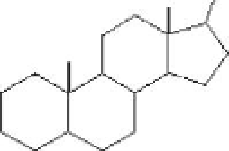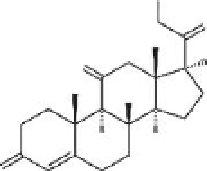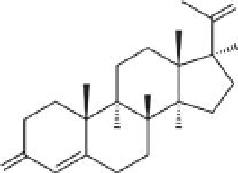Chemistry Reference
In-Depth Information
R
OH
R
17
O
11
12
13
16
R
D
C
OH
O
15
14
1
9
H
2
3
10
8
7
A
B
4
6
HH
5
O
The Steroid Carbon Skeleton
FIGURE 10.4
The steroid skeleton.
FIGURE 10.5
The structure of a medically
useful steroid cortisone.
10.3 STEROIDS FROM YAMS
The genesis of the birth control pill can be traced back to wild yams growing in Mexico.
The wild yam is a member of the Dioscoreaceae family comprising hundreds of spe-
cies. However, only four species are of relevance for medicinal purposes:
Dioscorea
villosa
(found in the United States);
Dioscorea opposita
and
Dioscorea hypoglauca
(native to Asia);
and the Mexican yam
, Dioscorea barbasco.
The oral contraceptive pill is a combination of an estrogen (estradiol) and a pro-
gestogen (progestin), and when females ingest these pills they inhibit fertility. They
were first approved for contraceptive use in the United States in 1960. Currently,
more than 100 million women use them worldwide.
The primary active chemical agent in wild yam is the steroidal saponin, known
as diosgenin. It is actually present in the roots of the wild yam as dioscin, a steroi-
dal saponin whose aglycone is diosgenin. The glycoside dioscin from the Mexican
wild yam root,
Dioscorea
, constituted the first significant sapogenin plant source
for steroid drugs and this compound can be chemically converted to the hormone
progesterone (Figure 10.6). The chemical steps of conversion from diosgenin to pro-
gesterone are shown in Figure 10.7.
O
H
H
H
H
O
FIGURE 10.6
The steroidal hormone progesterone.



Search WWH ::

Custom Search